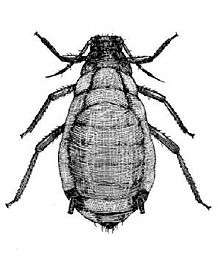Rhopalosiphum maidis
| Rhopalosiphum maidis | |
|---|---|
 | |
| Scientific classification | |
| Kingdom: | Animalia |
| Phylum: | Arthropoda |
| Class: | Insecta |
| Order: | Hemiptera |
| Suborder: | Sternorrhyncha |
| Family: | Aphididae |
| Genus: | Rhopalosiphum |
| Species: | R. maidis |
| Binomial name | |
| Rhopalosiphum maidis | |
| Synonyms | |
| |
Rhopalosiphum maidis, common names corn leaf aphid and corn aphid, is an insect, and a pest of maize and other crops.[2][3] It has a nearly worldwide distribution.
Distributed in the steppe and forest-steppe zones. It damages rice, sorghum, corn and other cultivated and wild cereals.
The wingless parthenogenetic female is of a species of greens and forms, whitish-green; head, antennae, legs, tubes, tail and transverse bands on the abdomen black-brown; body in sparse short hairs, the length of the antennae is less than half the length of the body; small tubes, not larger than finger-like tail. In the winged female, the head and thoracic section are black-brown, the tubules are shorter than in the wingless. Development is incompletely cyclical.
Winter winged parthenogenetic females and larvae on wild-growing cereals, from which spring and summer spread to rice fields. Fields populate gradually, starting from the edges to the center. The number of aphids in the center of the field reaches a maximum in early July.
Aphids settle from the underside of the leaves, in the sinuses, first on the tops, and then on the whole plant. On irrigated lynx, these pests appear first along the canals and on the shafts, as well as on plants weakened by disturbance of the water or nutrient regime. In August–September, winged insects settle on cereal weeds, where larvae and adults hibernate. Damaged leaves first brighten, then turn yellow, when the pest multiplies, they twist and dry. The pest is a carrier of viral diseases.
For a year, no less than 12 generations develop.
Protection measures. Depletion of aphids additional feed base by the destruction of weeds (channeling, spatial isolation of grain crops on land). Weed the weeds below the water level. Chemical protection by authorized drugs during EPO during sprouting-bushing of 1-2 individuals per stem in the tubular phase and later-10-15 individuals per stem. Together with the sorghum aphids, ordinary, large, grassy and other aphids, similar in nature to injuries, are damaged.
Hosts
References
- ↑ Fauna Europaea
- ↑ "Rhopalosiphum maidis (Fitch) - Maize Aphid". Ethiopia.ipm-info.org. 2008-05-03. Retrieved 2011-08-29.
- ↑ "Rhopalosiphum maidis". Extento.hawaii.edu. Retrieved 2011-08-29.